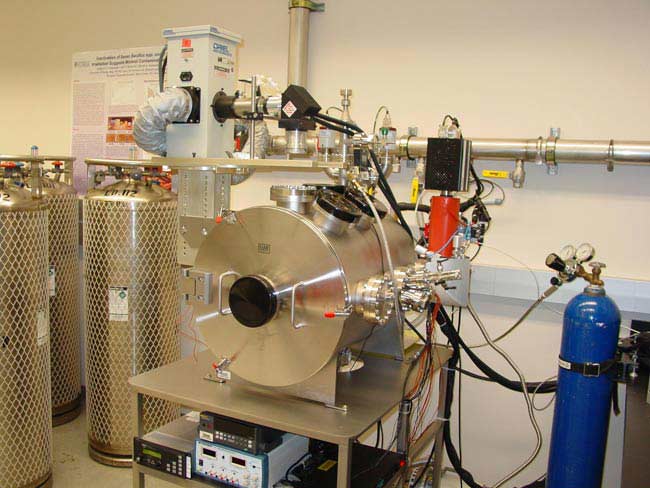Microbes Would Find Scarce Shelter on Mars

Extremophilebacteria can tough it out in the Siberian permafrost, but the environment ofMars may still be too hostile for such hardy life.
That?sthe finding of a recent study conducted by Andrew C. Schuerger, a microbiologistat the University of Florida and the Space Life Sciences Lab at NASA's KennedySpace Center in Florida, and colleagues.
"Veryseldom have microbes that grow well under cold or high salt conditions beensubjected to Martianconditions," said Schuerger.
Harshultraviolet (UV) light proved particularly devastating for the survival ofcold-resistant microbes under simulated surface conditions on Mars.
Suchfindings not only hone the search for traces of Martian life, but also couldhelp focus NASA's procedures to preventcontamination of Mars by Earth microbes.
ColdCase for a Small Suspect
Paststudies have focused on moderate-temperature microbes that pose a more commonrisk of contaminating spacecraft parts and hitching a ride into space. NASA haslong worried that contamination by Earth microbes could upset ongoing effortsto find Martian or other extraterrestrial life.
Breaking space news, the latest updates on rocket launches, skywatching events and more!
Schuergerand his colleagues chose to test Psychrobacter cryohalolentis, anextremophile that thrives under extremely dry conditions and at temperatures aslow as minus 10 degrees C. That choice allowed them to push scientificunderstanding of what may or may not survive on the Martian surface.
"Ifwe can find any of extremophilicterrestrial species that are capable of growth and replication underMartian conditions, it puts the search for life on Mars a bit closer tosuccess," Schuerger explained.
Testingunder Martian surface conditions meant turning to the Mars Simulation Chamber(MSC) at the Kennedy Space Center, where researchers simulated everything fromdust free skies to global dust storm conditions. The study grew out of theundergraduate work of David Smith from Princeton University, who has since goneon to conduct his Ph.D. research at the University of Washington.
Theteam also tested how well a salt mineral matrix similar to parts of the Martiansurface could protect against UV, and how well the extremophiles dealt withvery dry conditions.
NoEscape from UV
Turnsout that P. cryohalolentis finds precious little shelter from UVradiation, even under global dust storm conditions or sitting inside a saltmineral matrix.
"Wefound that the UV radiation was readily and easily able to penetrate thesalt-organic matrix that the bacterial cells were embedded in," Schuergersaid.
Suchfindings suggest that this type of extremophile poses little risk of spreadingacross the surface of Mars — at least not on its current-day hostile surfaceenvironment. P. cryohalolentis even fared poorly under the dryconditions on the lab bench, let alone inside the Mars simulator.
Thestudy points to a need for future investigations on how much UV protection amicrobe can find in salt mineral layers within the Martian regolith.
"Theresearch emphasizes the point that you're not going to automatically getprotection from UV when embedded within salt deposits," Schuerger noted."Some salt encrustations might protect with just a few millimeters ofsalt, while others might need 5 to10 centimeters."
UVis not the only challenge facing hitchhiking microbes. Schuerger's pastresearch found at least 13 separate factors on Mars that can kill Earthmicrobes, not counting perchlorate salts uncovered by NASA's Phoenix MarsLander in the polar region of Mars.
DiggingDeeper Into the Future
Still,current NASA missions to Mars take precautions with sterilization and cleanrooms to prevent contamination prior to launch.
"I'mnot overly worried that we're contaminating landing sights," Schuergersaid. "I'm not suggesting that we relax planetary protection protocols,either, but current ones appear to be very good."
That'snot to say that NASA missions don't pose any contamination risk, given the dustthat may get kicked up and cover surviving microbes with a protective layer, headded. Future missions that have landers or rovers digging deeper beyond thetop 10 or 20 centimeters of the Martian surface may require additional riskstudies.
"Whetheror not microbes will survive when we drill down to depth, that's a wide openquestion at this point," Schuerger cautioned. Studies like Schuerger?s,and more complex robotic or humanmissions to Mars over the next several decades, may provide some answers.
Thefull study is detailed in the March issue of the journal Astrobiology.
- Video Show - Rover Tracks on Mars
- Perchlorate Points to Possible Puddle
- A One-way Ticket to Mars
Jeremy Hsu is science writer based in New York City whose work has appeared in Scientific American, Discovery Magazine, Backchannel, Wired.com and IEEE Spectrum, among others. He joined the Space.com and Live Science teams in 2010 as a Senior Writer and is currently the Editor-in-Chief of Indicate Media. Jeremy studied history and sociology of science at the University of Pennsylvania, and earned a master's degree in journalism from the NYU Science, Health and Environmental Reporting Program. You can find Jeremy's latest project on Twitter.
